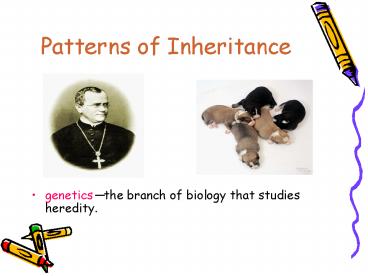Patterns of Inheritance - PowerPoint PPT Presentation
1 / 12
Title:
Patterns of Inheritance
Description:
... trait at a time to control variables, and he analyzed his data mathematically. ... An uppercase letter is used for the dominant allele and a lowercase letter for ... – PowerPoint PPT presentation
Number of Views:24
Avg rating:3.0/5.0
Title: Patterns of Inheritance
1
Patterns of Inheritance
- geneticsthe branch of biology that studies
heredity.
2
MENDELS PRINCIPLES
- Gregor Mendel, an Austrian monk, carried out
important studies of hereditythe passing on of
characteristics from parents to offspring. - Characteristics that are inherited are called
traits.
3
Mendel chose his subject carefully
- Modern genetics began with Gregor Mendels
quantitative experiments with pea plants - Mendel crossed pea plants that differed in
certain characteristics and traced the traits
from generation to generation - This illustration shows his technique for
cross-fertilization
4
Mendel was a careful researcher
- He studied only one trait at a time to control
variables, and he analyzed his data
mathematically. - The tall pea plants he worked with were from
populations of plants that had been tall for many
generations and had always produced tall
offspring. - Such plants are said to be true breeding
- A hybrid is the offspring of parents that have
different forms of a trait, such as tall and
short height.
5
- The original parents, the true-breeding plants,
are known as the P1 generation. - The offspring of the parent plants are known as
the F1 generation - When you cross two F1 plants with each other,
their offspring are the F2 generation
6
Mendels principle of segregation describes the
inheritance of a single characteristic
- From his experimental data, Mendel deduced that
an organism has two genes (alleles) for each
inherited characteristic - One characteristic comes from each parent
- A sperm or egg carries only one allele of each
pair - The pairs of alleles separate when gametes form
- This process describes Mendels law of
segregation
7
The rule of dominance I
- If two alleles differ, then one, the dominant
allele, is fully expressed in the organisms
appearance. - The other, the recessive allele, has no
noticeable effect on the organisms appearance. - Purple color is dominant over white
8
The rule of dominance II
- An uppercase letter is used for the dominant
allele and a lowercase letter for the recessive
allele. - The dominant allele is always written first.
- An organism is homozygous for a trait if its two
alleles for the trait are the same. PP (dominant)
or pp (recessive) - An organism is heterozygous for a trait if its
two alleles for the trait differ from each other.
(Pp) (dominant)
9
Phenotypes and Genotypes
- The way an organism looks and behaves is called
its phenotype. - The allele combination an organism contains is
known as its genotype. PP, Pp, or pp
10
Punnett Squares
- In 1905, Reginald Punnett, an English biologist,
devised a shorthand way of finding the expected
proportions of possible genotypes in the
offspring of a cross - A Punnett square predicts the results of a
genetic cross between individuals of known
genotype
11
Homologous chromosomes bear the two alleles for
each characteristic
- Alternative forms of a gene (alleles) reside at
the same locus on homologous chromosomes
12
The principle of independent assortment is
revealed by tracking two characteristics at once
- By looking at two characteristics at once, Mendel
found that the alleles of a pair segregate
independently of other allele pairs during gamete
formation - This is known as the principle of independent
assortment































